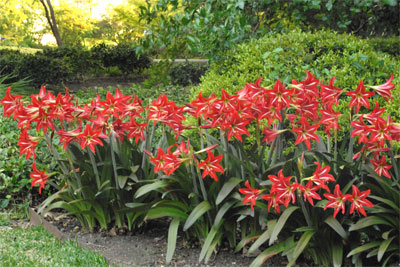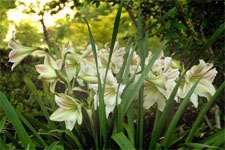From The Sperry Garden – April, 2009

It’s been probably 15 years since Steve and Anita were kind enough to bring me a start of hardy amaryllis, also known as St. Joseph’s lily. Botanically, it’s Hippeastrum x johnsonii. They dug up a clump on their way to our old garden show the end of that February.
I divided that original clump immediately after it bloomed, and I’ve divided its offspring several times in the ensuing years. Another such division is probably about to happen. Part of my plants have become obscured by shrubs, and I have new places to plant them. Gardens, after all, are never finished.
The old rule of thumb for perennials is that "if it blooms in the spring, you divide it in the fall" (and vice versa). That certainly works with hardy amaryllis, but I’ve had such good luck dividing them immediately after they finish blooming in the spring that I’m kinda stuck in that pattern. I do it as soon as the flowers have shriveled (that will be in just a few days, as this photo was taken 6 days ago). I’ll have the soil in their new location tilled and mixed, so that they’ll be out of the ground as short a time as possible.

The second photo is of another hardy amaryllis. I asked my radio audience three years ago if anyone might have a start of a hardy "candystripe" amaryllis, and a kind lady named Lou contacted me to share this one. It, too, has thrived, so I asked my good friend Greg Grant from Nacogdoches about its specific lineage. Here is what he wrote back:
"Appears to be Hippeastrum vittatum, one of the parents of Hippeastrum x johnsonii (along with the green and white throated H. reginae). It will probably be hardy for you (in DFW) at least with a little protection, as both parents are fairly hardy. Those three, along with other related hybrids between them make up the majority of the ‘yard amaryllis’ I see in the South."
Finally, a quick word about the tropical amaryllis bulbs and plants you see being sold around Christmas. Those types have fuller, flatter flowers. They’re beautiful, but they’re not reliably winter-hardy in the northern half of the state (in normal winters) unless they’re protected.
Your best bet with these will be to leave them in pots, and grow them on from Christmas until early September. At that time, you want to force them into dormancy by turning their pots on their sides and letting the plants dry out and shrivel. A few weeks later, take the bulbs out of their pots and work all the soil away from them. Repot the bulbs back into the same pots using fresh potting soil. Put them in a bright location, and water them deeply. The dry spell should trigger the next blooming cycle, which should come sometime near Christmas. No guarantees, but it usually works.

